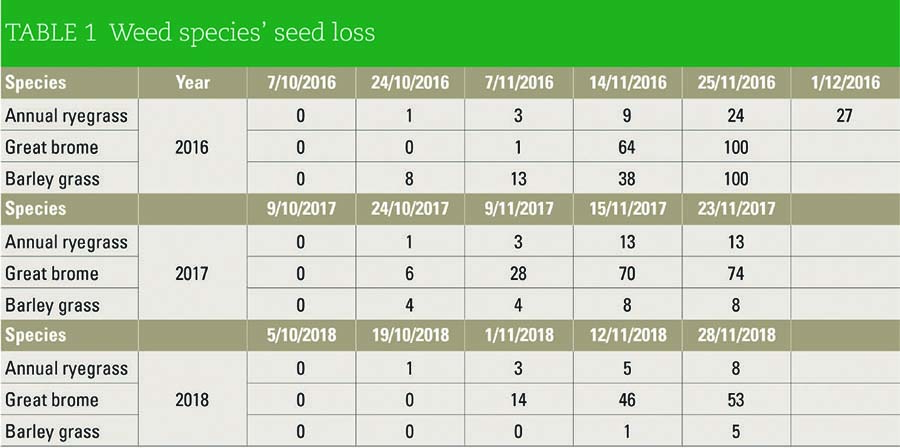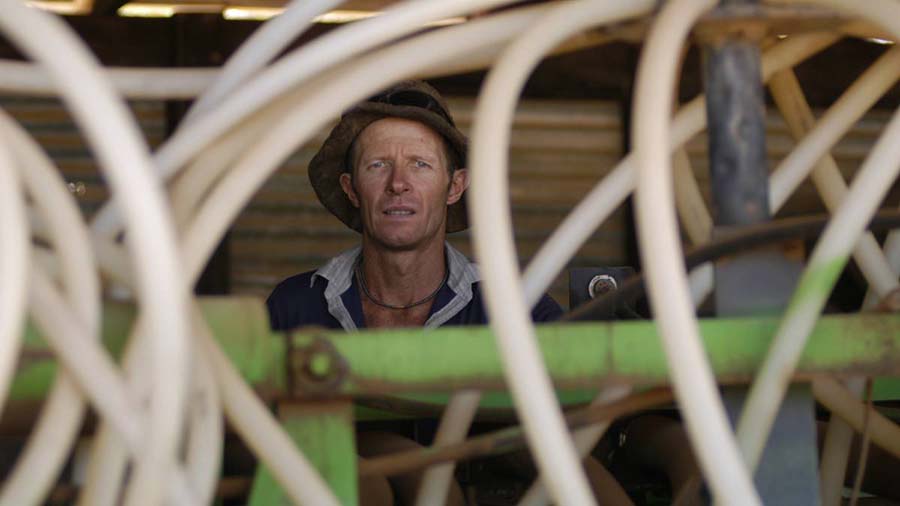Factbox
- Researchers have identified brome grass as the fourth most detrimental weed nationally, with an estimated revenue loss of $22.5 million.
- Barley grass ranks at number none, at a cost of $1.7m to the industry.
- The trials showed great brome held most seed until November.
- In the trials, barley grass began shedding its seed in October and continued shedding until the end of November.
Research conducted in Western Australia's central wheatbelt is highlighting the variability of seed shedding periods between great brome and barley grass populations.
For growers, this may mean that no single harvest weed seed control (HWSC) formula will fit all paddocks, and tailored weed management strategies may be needed on a paddock-by-paddock, and weed-by-weed, basis.
Department of Primary Industries and Regional Development (DPIRD) research officer Dr Catherine Borger says trials run from 2016 until 2018 have shown barley grass shedding periods can be highly variable.
In contrast, trials showed great brome dropped large percentages of seed in short periods of time.
Dr Borger says this GRDC-invested research has emphasised the importance of knowing the type and growth stage of individual weed populations in order to apply appropriate weed management strategies.
The trials compared seed shedding stages of great brome and barley grass with annual ryegrass, to determine the effectiveness of using mechanical harvest weed seed destruction strategies to eliminate the seed.
Dr Borger says the effectiveness of harvest weed seed control (HWSC) on annual ryegrass is well-documented and the trials reaffirmed ryegrass retained most of its seed until the harvest period, making it suitable for HWSC.
"We conducted this research to determine if the same strategy could be effective on both great brome and barley grass," she says.
Researchers have identified brome grass as the fourth-most-detrimental weed nationally, with an estimated revenue loss of $22.5 million.
Barley grass ranks at number nine, at a cost of $1.7m to the industry.
The results
In the trials at Wongan Hills across the three years, Dr Borger says, barley grass began shedding its seed in October and continued shedding until the end of November, meaning a harvest weed seed destruction strategy would not catch all seed.

The cumulative percent of seed loss by each weed species from early October to the date of harvest in 2016, 2017 and 2018. Note that the crop reached maturity (earliest possible date that harvest could have been completed) on 14 November 2016, 9 November 2017 and 12 November 2018. Source: DPIRD
More importantly, the mature barley grass at Wongan Hills was quite short, at only 10 to 15 centimetres, presenting a problem for capturing it in the header front.
"Capturing all the seed from a mature barley grass population would be almost impossible," Dr Borger says.
"It may be possible to capture a proportion of the seed at harvest, but other strategies, such as in-season herbicide control of barley grass, would be more effective for this weed."
The trials showed great brome held most seed until November, shedding this seed quickly - in some cases up to 70 per cent - in just one week.
Dr Borger says since this weed is often as tall as the crop, it is more suited to HWSC if the crop can be harvested before this seed shed period.
"Any paddocks that have a great brome population that you are attempting to manage using HWSC should be harvested as early as possible," Dr Borger says.
But harvesting great brome isn't always simple, she says.
If the weeds have not matured and dried out at the same time as the crop, due to late weed emergence or good spring rain, the plants may be tough, stringy and difficult to cut.
Lodging of weed seed heads can also create problems during harvest. This can be a particular problem with great brome.
Escaping the knife
In contrast to this Wongan Hills research, Kellerberrin grower Kit Leake says he has seen great brome populations still standing after a header pass.

Kellerberrin grower Kit Leake has seen great brome populations survive the harvesting process, meaning seed bank populations are increasing for future seasons. Photo: Brad Collis
"In 2017, when we had good rains in August, we saw late-germinating great brome populations which, even though they were tall enough to be harvested, were pulled through the header front," he says.
"The plants still had the seeds intact, and were left standing in the paddock."
Since the seeds were still held on the plant, they could not germinate in response to autumn rainfall to be killed with knockdown herbicides.
"A canola rotation in that same paddock the following year meant the great brome couldn't be targeted within the crop and so these seeds will continue to be a problem for the next few years," Kit says.
"It simply means we missed an opportunity to control the brome in that rotation."
Dr Borger says if soil disturbance from seeding a canola crop isn't enough to bury any surviving seed remaining on the brome grass plant, it would mean that these seeds would continue to be a problem in future years.
Another possible solution to this problem, Kit says, would be to harvest at very slow speeds, which is often unviable in large broadacre holdings but might be considered for a small area with a severe great brome problem.
Chaff lining for success
Esperance grower Mic Fels attacks his brome grass using chaff lines behind the harvester.
Chaff lining involves making a simple chute to divert the chaff-only fraction (off the harvest sieves) into a narrow windrow, which is left to rot while the straw is chopped and spread.
 Esperance grower Mic Fels attacks his brome grass using chaff lines behind the harvester. Photo: Evan Collis
Esperance grower Mic Fels attacks his brome grass using chaff lines behind the harvester. Photo: Evan Collis
Mic has had significant success over the past few years in reducing brome grass weed seed numbers through this process and says he doesn't need to apply any herbicides to the chaff lines.
"We have areas of non-wetting soils that seem to really suit brome grass, and paddocks coming out of a long pasture phase can present us with a problem," he says.
"We have found that in the first year or two, the brome grass comes up thick in the chaff lines, but it only takes a few years with normal agronomic management and then the chaff lines are virtually brome grass-free."
Mic says harvest speeds of eight to 12 kilometres per hour in this higher-rainfall region, particularly in higher-yielding years, may be slower than lower-rainfall regions and could be helping to capture the brome in the chaff.
"Unfortunately, for us, ryegrass is not as easy to beat with chaff lining as brome," he says.
"While it does still work on ryegrass here, a percentage of ryegrass seed either sheds before harvest, or goes out through the chopper if it's still a bit green when we're harvesting."
He says different weeds seem to respond differently to the various management strategies, depending on the environment and the rainfall.
"Chaff lining seems to work for us here, and I rate brome (and marshmallow) as the most effective weeds to manage with chaff lining, and we don't seem to get too many plants escaping the knife," he says.
"Unless the crop has bad ryegrass, we cut as high as we can for harvest efficiency, and we still seem to catch the majority of the brome grass seed in those old stock camp areas."
Mic says narrow row spacings encourage the individual plants to grow more upright, which improves the effectiveness of harvest weed seed capture.
Dr Borger says the best ways to monitor the maturity of both great brome and barley grass is to walk into paddocks and look at the heads.
"Take a photo with your phone in spring when the plants are still green but the heads are out, to remind yourself what the heads look like with all the seeds attached," she says.
"Then go back close to harvest to see how much shedding has occurred - comparing the heads with your previous photo."
Take home messages
- Know your weed populations
- Seed shed from barley grass is variable, HWSC may not be suitable weed control method
- Be prepared to harvest early in the season to have the best chance to control great brome
- Control options may include chaff lining, particularly in higher rainfall regions
- Think about: how tall are your weeds? How early do they shed? Are the plants dry at harvest and easy to cut?
More information: Dr Catherine Borger, catherine.borger@dpird.wa.gov.au

























































